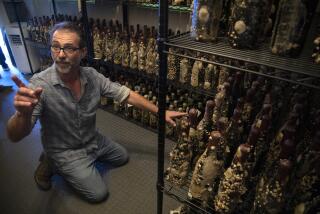Bogus Mrs. Fields Chocolate Chip Cookie Recipe Is Making the Rounds
- Share via
What appeared at first to be the work of a dissatisfied baking buff has actually become a cookie caper of potentially damaging proportions for one of the nation’s more successful food franchise companies.
A leaflet of unknown origin has been distributed in chain-letter fashion throughout the country during the past several months claiming to reveal the Mrs. Fields chocolate chip cookie recipe. The formula provided on the single sheet of paper purports to duplicate the one used for the premium treats sold by the more than 375 Mrs. Fields outlets around the nation.
Not only did the flyer provide the recipe, but it also claimed that the information was being offered to all interested parties because an anonymous consumer had been grossly overcharged by the Park City, Utah-based company.
There are several variations to the memo, but one of the more common versions states that, “A woman who works with the American Bar Assn. called Mrs. Field’s cookies and asked for the attached recipe. She assumed (the cost) was $2.50 and she charged it to her Visa (credit card). It was not $2.50 but $250.”
The flyer goes on to state that because of the substantially inflated price the recipe is being distributed free in retaliation.
Since its inception, the mystery flyer has made the rounds of cookie circles across the nation, been printed in more than a dozen newspapers and even distributed to prospective home buyers by real estate agents.
It turns out that the recipe is only an imitation of the real Mrs. Fields cookie and did not originate with the company. In fact, the process responsible for the firm’s popular sweets is a proprietary secret and, as such, is protected by U.S. trade laws. Furthermore, Mrs. Fields does not accept any credit cards, nor does it sell recipes.
An executive of the cookie company is not amused by the long-lived memo and has unsuccessfully attempted to track down the perpetrator of the ruse. At one point, a woman in Texas was offered $1,000 to produce the receipt that purportedly had been given at the time of the recipe’s purchase. The woman declined to produce the voucher.
In the meantime, signs have been posted in all Mrs. Fields stores and a disclaimer added to all the firm’s packaging denying any link to the bogus recipe.
“For sure, it is not our recipe,” said Randy Fields, the firm’s executive vice president and spouse of the founder, Debbi Fields. “That recipe isn’t even close. We have made it and it’s not a good cookie.”
However, others who have prepared the mystery formula claim that the cookies are quite enjoyable and found a similarity to the commercial product.
Nevertheless, Fields says that it is virtually impossible to duplicate his company’s cookie even if the secret recipe was revealed. Consumers would be unable to obtain the commercial ingredients used by the company and do not have the equipment necessary for the product.
“Virtually every one of our ingredients is specially formulated to our specifications,” Fields said. “Even if you tried to buy them from our suppliers you couldn’t and we won’t even reveal their names.”
The company has received a number of complaints about various aspects of the recipe and Fields is concerned that the incident has hurt the firm’s image.
Fields speculates that a competitor in the gourmet cookie business is the most likely source of the problem.
“One could imagine a competitive reason (for circulating the flyer). Some of our competitors are not the nicest people in the world and they would do anything they could to besmirch our reputation,” he said. “It certainly is worrisome.”
Fields claims that only three people actually know the recipe for the chocolate chip cookie. All are still with the company and were not involved with this episode.
Screw-Top Myth Corked--The quality of wine is often judged by the type of closure that keeps it in the bottle. Those sealed with screw tops tend to be inexpensive and unappreciated by wine aficionados. On the other hand, wines bottled with a cork finish are often given an automatic sense of legitimacy--whether or not the respect is deserved.
Now it appears that poor wine should not be blamed on the simple presence of a screw top, according to a presentation last week at the American Chemical Society’s annual convention in Anaheim.
A screw top actually may be as effective a way of protecting a vintage wine from the potentially damaging effects of excessive oxygen as are corks, reported I. J. Wilk, an independent consultant who analyzed the issue.
Wilk, a Stanford, Calif.,-based chemist, joined R. Scott Altmann from the University of Geneva in a research project that monitored both the salutary and damaging effects of oxygen on wine.
The research on closures involved measuring the dissolved oxygen in one wine sealed with a cork and another with a metal top. The work focused on dissolved oxygen because it is essential for aging and must be present in just the right amount in order for wines to improve.
Wilk found that the levels of dissolved oxygen particles in the two differently sealed containers were about the same after 150 days--thus indicating that the screw-top maintained the integrity of the wine as well as did the cork.
Another myth unsupported by laboratory testing was the practice of letting an uncorked bottle of wine breathe before serving in hopes of unleashing its best characteristics. The limited amount of oxygen that reaches the wine through the bottle’s neck has only a minimal effect on wine. A better way of bringing out a wine’s qualities is to swirl it for several seconds in a goblet, Wilk found.
Decanting is also an unpredictable practice that can actually destroy a fine wine of considerable age with a damaging infusion of air, Wilk found.
Despite the chemists’ scrutiny, wine remains a fickle substance. More than a century ago, French chemist Louis Pasteur discovered that wine in airtight containers did not improve with the passing of time. It was only when it is exposed to a controlled amount of oxygen, such as the airspace found today in all wine bottles, that the desired characteristics develop.
Beer Bash Rebounds--Things looked bleak for the Great American Beer Festival earlier this year when event organizers were unable to acquire liability insurance. Underwriters were hesitant to insure a two-day affair where 5,000 people were to enjoy 125 different domestic beers in Denver’s Regency Hotel ballroom.
The potential risk of property damage or personal injury resulting from inebriates forced the organizers, the Boulder, Colo.,-based Assn. of Brewers, to re-evaluate their goals. After drastically redesigning the festival to reduce overindulgence, the group was able to acquire insurance and the event will take place as scheduled Oct. 3 and 4.
Some of the measures adopted by the association include pouring only one-ounce beer samples, training servers to spot drunkenness and offering cab rides and affordable hotel rates for those unable to drive, according to Daniel Bradford of the brewers association.
“For the average adult male to exceed the blood alcohol content intoxication level at the Great American Beer Festival, it would take 36 separate (one-ounce) servings of beer in one hour’s time. And that is physically impossible,” Bradford said.
Can a connoisseur actually capture a beer’s essence and body after only a one-ounce taste?
“You don’t get an entire ounce in your mouth at once at a wine tasting--it’s actually about one-third of an ounce . . . So, you’ll be able to get a (full) taste,” he said.
Despite the problems with insurance, Bradford said all the concerns over potential festival drunkenness are not completely warranted.
“In the three years we have had this event I’ve only ejected six people and I can’t say how much of that was due to unruly conduct or inebriation,” he said.
More to Read
Eat your way across L.A.
Get our weekly Tasting Notes newsletter for reviews, news and more.
You may occasionally receive promotional content from the Los Angeles Times.









